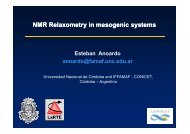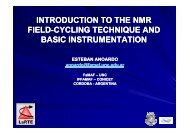Download Program and abstract book - 8th Conference on FFC ...
Download Program and abstract book - 8th Conference on FFC ...
Download Program and abstract book - 8th Conference on FFC ...
Create successful ePaper yourself
Turn your PDF publications into a flip-book with our unique Google optimized e-Paper software.
Oral 06<br />
Abstract<br />
TRANSIENT ACCESS TO THE PROTEIN INTERIOR:<br />
MAGNETIC RELAXATION DISPERSION VERSUS SIMULATION<br />
Filip Perss<strong>on</strong> <str<strong>on</strong>g>and</str<strong>on</strong>g> Bertil Halle<br />
Dept of Biophysical Chemistry, Lund University, SE-22100 Lund, Sweden<br />
Many proteins rely for their functi<strong>on</strong> <strong>on</strong> rare structural fluctuati<strong>on</strong>s whereby solvent <str<strong>on</strong>g>and</str<strong>on</strong>g> other<br />
small molecules gain transient access to internal cavities. In magnetic relaxati<strong>on</strong> dispersi<strong>on</strong><br />
(MRD) experiments, water molecules buried in such cavities can be used as intrinsic probes<br />
of the intermittent protein moti<strong>on</strong>s that govern their exchange with external solvent. While<br />
this has allowed a detailed characterizati<strong>on</strong> of exchange kinetics for several proteins, 1 little is<br />
known about the exchange mechanism. Here, 2 we use a millisec<strong>on</strong>d all-atom MD trajectory 3<br />
to characterize water exchange from the four internal hydrati<strong>on</strong> sites in the protein BPTI.<br />
Using a recently developed stochastic point process approach, 4 we compute the survival<br />
correlati<strong>on</strong> functi<strong>on</strong> probed by MRD experiments as well as other quantities designed to<br />
validate the exchange-mediated orientati<strong>on</strong>al r<str<strong>on</strong>g>and</str<strong>on</strong>g>omizati<strong>on</strong> (EMOR) model used to interpret<br />
the MRD data. The EMOR model is found to be quantitatively accurate <str<strong>on</strong>g>and</str<strong>on</strong>g> the simulati<strong>on</strong><br />
reproduces the experimental mean survival times for all four sites with activati<strong>on</strong> energy<br />
discrepancies in the range 0 – 3 k B T. On the other h<str<strong>on</strong>g>and</str<strong>on</strong>g>, the simulated hydrati<strong>on</strong> sites are<br />
somewhat too flexible <str<strong>on</strong>g>and</str<strong>on</strong>g> the water flip barrier is underestimated by up to 6 k B T. The<br />
simulati<strong>on</strong> reveals that water molecules gain access to the internal sites by a transient<br />
aqueduct mechanism, where single-file water chains migrate through transient (< 5 ns)<br />
tunnels <str<strong>on</strong>g>and</str<strong>on</strong>g> pores (see MD snapshot below).<br />
_________________________________________________________<br />
1 E Perss<strong>on</strong> & B Halle, J Am Chem Soc 130, 1774 (2008).<br />
2 F Perss<strong>on</strong> & B Halle, J Am Chem Soc, in press.<br />
3 DE Shaw et al., Science 330, 341 (2010).<br />
4 B Halle & F Perss<strong>on</strong>, J Chem Theory Comput, in press.<br />
<str<strong>on</strong>g>8th</str<strong>on</strong>g> <str<strong>on</strong>g>C<strong>on</strong>ference</str<strong>on</strong>g> <strong>on</strong> Fast Field Cycling NMR Relaxometry, Turin 23-25 May 2013




